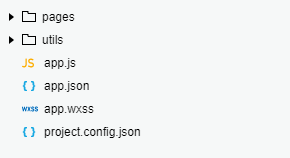在我们开发小程序的时候,都是利用微信开发者工具来开发(这是一句废话,凑字数用的).
因此,一般我们创建好项目,默认为下图:

至于每个文件夹和文件的功能我就不废话了,相信大家看看文档都知道...(下面是文档传送地址)
https://mp.weixin.qq.com/debug/wxadoc/dev/api/
现在我就讲讲我的小程序实战开发中文件夹存放那些内容:
utils
这个文件夹我会存放一些比如qrCode.js,sha1.js,utils.js...
具体功能:
- qrCode是做啥的,相信大家都很熟悉,是做二维码用的,不过小程序有规定,所以慎用...
- sha1.js应该也有很多人知道,其实就是一种加密算法,详情百度,这个还算是很安全的...
- utils.js我会在里面封装自己的请求方式,和一些给后台传输数据的方法,类似于诸葛追踪插件(但是我写的很粗糙,勿喷)
utils.js具体代码如下:
const formatDay = date => { const year = date.getFullYear() const month = date.getMonth() + 1 const day = date.getDate() return [year, month, day].map(formatNumber).join('-') } const formatNumber = n => { n = n.toString() return n[1] ? n : '0' + n } const formatTime = date => { const year = date.getFullYear() const month = date.getMonth() + 1 const day = date.getDate() const hour = date.getHours() const minute = date.getMinutes() const second = date.getSeconds() return [year, month, day].map(formatNumber).join('/') + ' ' + [hour, minute, second].map(formatNumber).join(':') } /** * url 请求地址 * success 成功的回调 * fail 失败的回调 */ function _get(url, success, fail) { wx.request({ url: url, header: { // 'Content-Type': 'application/json' }, success: function (res) { success(res); }, fail: function (res) { fail(res); } }); } /** * url 请求地址 * success 成功的回调 * fail 失败的回调 */ function _post_from(url, data, success, fail) { wx.request({ url: url, header: { 'content-type': 'application/x-www-form-urlencoded', }, method: 'POST', data: data, success: function (res) { success(res); }, fail: function (res) { fail(res); } }); } /** * url 请求地址 * success 成功的回调 * fail 失败的回调 */ function _post_json(url, data, success, fail) { wx.request({ url: url, header: { 'content-type': 'application/json', }, method: 'POST', data: data, success: function (res) { success(res); }, fail: function (res) { fail(res); } }); } function _post_urlencoded(url, data, success, fail) { wx.request({ url: url, header: { 'content-type': 'application/x-www-form-urlencoded', }, method: 'POST', data: data, success: function (res) { success(res); }, fail: function (res) { fail(res); } }); } function getXcxId(fun, callback) { wx.getStorage({ key: 'xcxId', success: function (res) { return fun(callback) }, fail: function (res) { wx.getUserInfo({ success: function (res) { let newCode = res wx.login({ success: res => { if (newCode.encryptedData == "" || newCode.encryptedData == undefined || newCode.encryptedData == null) { getXcxId(fun, callback) } else { if (res.code) { _post_from('请求的链接', { code: res.code, platform: 0, wechatChild: 2, iv: newCode.iv, encryptedData: newCode.encryptedData }, res => { wx.setStorageSync('xcxId', res.data.xcxID); wx.setStorageSync('token', res.data.token); wx.setStorageSync('timestamp', res.data.timestamp); console.log("登录完成") return fun(callback) }) } else { return fun(callback) } } } }) } }) } }) } function getStorageXcxId(callback) { console.log("有ID了?") let xcxId, token, timestamp; wx.getStorage({ key: 'xcxId', success: function (res) { ttxId = res.data; wx.getStorage({ key: 'token', success: function (res) { token = res.data; wx.getStorage({ key: 'timestamp', success: function (res) { timestamp = res.data; if (xcxId!= "") { console.log("ok") callback(xcxId, token, timestamp) } else { console.log("无ID") getXcxId(getStorageXcxId, callback) } } }) } }) }, fail: function () { getTTXID(getStorageXcxId, callback) } }) } function track(where) { wx.getSetting({ success(res) { if (!res.authSetting['scope.userInfo']) { wx.authorize({ scope: 'scope.userInfo', success() { wx.getUserInfo({ success: function (res) { wx.reportAnalytics(where, { city: res.userInfo.city, sex: res.userInfo.gender, }); } }) } }) } else { wx.getUserInfo({ success: function (res) { wx.reportAnalytics(where, { city: res.userInfo.city, sex: res.userInfo.gender, }); } }) } } }) } module.exports = { _get: _get, _post_from: _post_from, _post_json: _post_json, _post_urlencoded: _post_urlencoded, getXcxId: getXcxId, getStorageXcxId: getStorageXcxId, track: track, formatDay: formatDay, formatTime: formatTime }
请求方式是采用的网上大神们总结的请求方式
track方法就是追踪方法,比如说追踪用户从那个小程序点击进入,以及携带用户信息传给后台...相信大家做过前后交互的都知道如何使用
接下来我们就开始对app.js进行详细讲述
//app.js
const myRequest = require("utils/util.js");//引入自己封装的请求方式
App({
data: {
xcxId: "",
token: "",
timestamp: ""
},
onLaunch: function () {
//调用API从本地缓存中获取数据
wx.showLoading({
title: '加载中',
});
this.getUserInfo()
},
getUserInfo: function () {
let that = this;
active()
function active() {
wx.getSetting({
success(res) {
if (!res.authSetting['scope.userInfo']) {//用户信息
wx.authorize({
scope: 'scope.userInfo',
success() {
wx.getUserInfo({
success: function (res) {
let newCode = res
wx.login({
success: res => {
let code = res.code;
wx.getStorage({
key: 'xcxId',
success: function (res) {
that.data.xcxId= res.data;
wx.getStorage({
key: 'token',
success: function (res) {
that.data.token = res.data;
wx.getStorage({
key: 'timestamp',
success: function (res) {
that.data.timestamp = res.data
if (that.data.timestamp == "" || that.data.xcxId== "" || that.data.token == "" || that.data.timestamp == undefined || that.data.xcxId== undefined || that.data.token == undefined || that.data.timestamp == null || that.data.xcxId== null || that.data.token == null) {
fail(code, newCode)
}
},fail:function () {
fail(code, newCode)
}
})
},fail:function () {
fail(code, newCode)
}
})
},fail:function () {
fail(code, newCode)
}
})
}
})
}
})
}
})
} else {
wx.getUserInfo({
success: function (res) {
let newCode = res
wx.login({
success: res => {
let code = res.code;
wx.getStorage({
key: 'xcxId',
success: function (res) {
that.data.xcxId= res.data;
wx.getStorage({
key: 'token',
success: function (res) {
that.data.token = res.data;
wx.getStorage({
key: 'timestamp',
success: function (res) {
that.data.timestamp = res.data
if (that.data.timestamp == "" || that.data.xcxId== "" || that.data.token == "" || that.data.timestamp == undefined || that.data.xcxId== undefined || that.data.token == undefined || that.data.timestamp == null || that.data.xcxId== null || that.data.token == null) {
fail(code, newCode)
}
},fail:function () {
fail(code, newCode)
}
})
},fail:function () {
fail(code, newCode)
}
})
},fail:function () {
fail(code, newCode)
}
})
}
})
}
})
}
}
})
}
function fail(code, newCode) {
if (code != "" && code != undefined && newCode != "" && newCode != undefined) {
getXcxId(code, newCode)
} else {
that.getUserInfo()
}
}
function getXcxId(code, newCode) {
myRequest._post_from('请求的链接',
{
code: code,
platform: 0,
wechatChild: 2,
iv: newCode.iv,
encryptedData: newCode.encryptedData
}, res => {
if (res.data.xcxId != "") {
wx.setStorageSync('xcxId', res.data.xcxId);
wx.setStorageSync('token', res.data.token);
wx.setStorageSync('timestamp', res.data.timestamp);
that.data.xcxId= res.data.xcxId;
that.data.token = res.data.token;
that.data.timestamp = res.data.timestamp;
}
})
}
}
});
具体思路就是先从本地获取用户信息,获取到之后返回给后台,毕竟每个公司都有自己的用户信息库,这样就是资源...
(未完待续....)




















 1万+
1万+

 被折叠的 条评论
为什么被折叠?
被折叠的 条评论
为什么被折叠?








